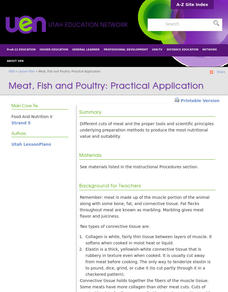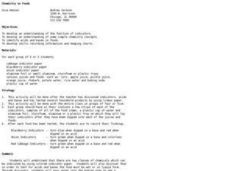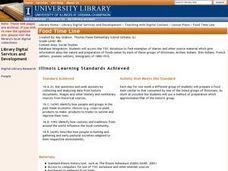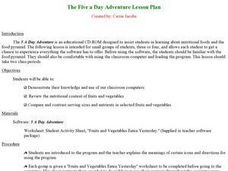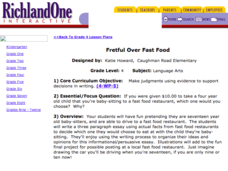Curated OER
What Food Is It?
Students close their eyes and taste foods without using the sense of sight to identify the foods. They record what they think the food is that they tasted.
Science Matters
Oh Heron
Two teams—the environmentalists and herons—play four rounds of the game, Oh Heron. Using hand symbols to represent food, shelter, and water, players locate their match to produce more herons while those unmatched decompose.
Curated OER
The Living Environment
For this living environment worksheet, young scholars complete a crossword puzzle given 34 clues about the various species in the environment that produce, consume and decompose. Topics also include photosynthesis, respiration, glucose,...
Curated OER
Meat, Fish and Poultry: Practical Application
A note-taking outline is given to learners which covers meat composition and quality, types of meat and storage, and cooking meat. By viewing pictures they learn to identify cuts of meat or poultry products. They discuss inspection and...
Teach Engineering
Engineers Love Pizza, Too!
Help overcome challenges in eating pizza. Scholars work in groups to design a device that assists a physically handicapped person eat pizza. They build a prototype of such a device to test their designs before building. To finish, groups...
Child Care Lounge
Learning Foundations Curriculum
Here is a collection of activities that complements each of the five senses. Youngsters explore textures, sounds in song, food tastes and aromas, colors and patterns, and a variety of experiences that boost individuals' knowledge about...
University of Southern California
How do Organisms Interact?
Examine how organisms interact through a hands-on experience. Learners study population dynamics and distribution during an informative five-lesson unit. The focus is on the ocean environment and the organisms within it.
Curated OER
Chemistry in Foods
Students investigate foods that are indicators, and acids and bases. In this food chemistry lesson plan, students test household products with litmus paper and with food indicators. They use blackberry, onion and red cabbage indicators...
Curated OER
Green Genes: Genetically Modified Organisms in Our Food
Students investigate how and why genetically modified organisms are used as food crops. They identify the advantages and disadvantages of these crops through internet research then present their views and discuss them as a large group.
Curated OER
Measuring Calories in Food
Learners measure the amount of calories in food. In this food energy lesson, students discuss what a calorie is, how our bodies use a calorie, and how many we need. Then, learners use a calorimeter to calculate the amount of energy in a...
Curated OER
Esters as Food Flavorings
Students produce esters in the laboratory by combining different carboxylic acids with different alcohol. In this esterification lesson plan, students experiment with 3 carboxylic acids and 3 alcohols to produce 3 esters with fruit like...
Curated OER
Ethical Ways to Acquire and Distribute Fish as a Food Source
Students complete a variety of activities as they examine the ethics of acquiring and distributing fish as a food source. They touch on the ethics involved in genetically modified salmon, as well.
Curated OER
Pre-Colonial Native American Groups
Students investigate U.S. history by researching the Internet and taking a test. In this American Indian group lesson plan, students identify the many specific Native American tribes and their geographic locations. Students research the...
Curated OER
Get a Feel for Food
Students describe the size, shape and feel of a food hidden in a "feely bag" and then select the Food Model from a group that corresponds to the food. In a tasting party afterwards, they sample the food and describe the color, taste and...
Curated OER
Science Unit Lesson Five
Sixth graders review how and which plants operate in terrariums. In groups, they follow instructions to make their own terrarium and place different types of plants in it. To end the lesson, they review the steps in the water cycle and...
Curated OER
My Pyramid Tag
Students explore the food pyramid and healthy eating. After discussing the five healthy food groups, students participate in activities to demonstrate the benefits of healthy food groups. They play games to discover the benefits of...
Curated OER
How Much Nutritional Value Does Rice Really Have?
Fifth graders see the nutritional value of rice. In this healthy eating lesson, 5th graders view the Food Guide Pyramid and the number of servings one is supposed to eat in each food group. They focus on rice and its benefits for the body.
Curated OER
Matching Meals Nutrition
Students play a matching game to practice pairing foods with their food groups. In this health and nutrition lesson, the class discusses food choices, then students play an on-line memory game.
Curated OER
Food Time Line
Fourth graders make a timeline to include the immigrants of 1880-1910. Then, in groups, they research foods consumed, purchase, and serve it to the class.
Curated OER
The Five a Day Adventure Lesson Plan
Students, after examining a food pyramid, demonstrate their knowledge and use of their classroom computers by researching the nutritional content of fruits and vegetables. They also compare/contrast serving sizes and nutrients in...
Curated OER
Fretful Over Fast Food
Fifth graders research fast food options and write an essay on the topic. In this fast food lesson, 5th graders pretend they are a babysitter and research fast food restaurant options to eat at while they are baby-sitting. Students write...
Curated OER
Get Your Calcium-Rich Foods
Sixth graders explore foods in the dairy group. In this dairy food lesson, 6th graders examine the nutritional value of dairy foods and determine the proper number of dairy servings per day. Students also evaluate numerous food labels of...
Curated OER
Count and Non-count Nouns- Food
In this grammar worksheet, students complete 5 lists of count or non-count nouns with the one that belongs from the word bank at the top of the page. They see colorful clip art pictures of fruit, cheese, fish, and pasta.
Polar Trec
Bioaccumulation of Toxins
In 2015, Peter Cook found that sea lions with high levels of exposure to toxins suffered permanent brain damage if they survived at all. Scholars learn about the accumulation of toxins at various levels of the food chain. Using...





